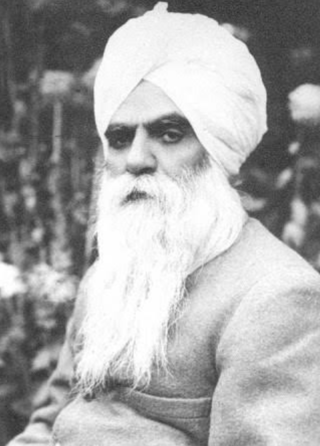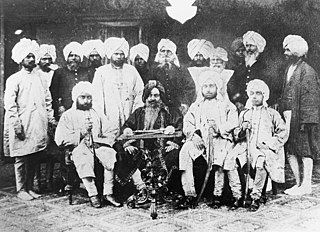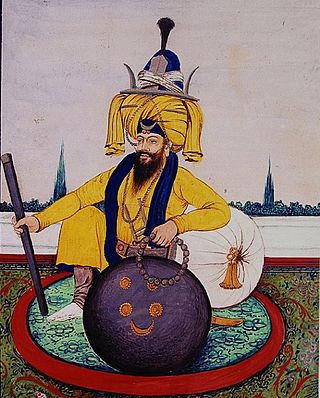The following outline is provides an overview of Sikhism, or Sikhi.

Pratap Singh Giani was a Sikh academician, scholar and calligraphist.

Bhai Mani Singh was an 18th-century Sikh scholar and martyr. He was a childhood companion of Guru Gobind Singh and took the vows of Sikhism when the Guru inaugurated the Khalsa in March 1699. Soon after that, the Guru sent him to Amritsar to take charge of Harmandir Sahib, which had been without a custodian since 1696. He took control and steered the course of Sikh destiny at a critical stage in Sikh history. He was also a teacher of the Gianian Bunga, later becoming known as the "Amritsari Taksal", currently located in Sato Ki Gali.

The Tat Khalsa, also romanised as Tatt Khalsa, known as the Akal Purkhias during the 18th century, was a Sikh faction that arose from the schism following the passing of Guru Gobind Singh in 1708, led by his widow Mata Sundari, opposed to the religious innovations of Banda Singh Bahadur and his followers. The roots of the Tat Khalsa lies in the official formalization and sanctification of the Khalsa order by the tenth Guru in 1699.

Khalsa College is a historic educational institution in the northern Indian city of Amritsar in the state of Punjab, India. Founded in 1892, the sprawling 300-acre (1.2 km2) campus is located about eight kilometers from the city-center on the Amritsar-Lahore highway, adjoining Guru Nanak Dev University campus, to which Khalsa College is academically affiliated.

Bhai Parmanand was an Indian nationalist and a prominent leader of the Ghadar Party and Hindu Mahasabha.

Vir Singh was an Indian poet, scholar and theologist of the Sikh revival movement, playing an important part in the renewal of Punjabi literary tradition. Singh's contributions were so important and influential that he became canonized as Bhai, an honorific often given to those who could be considered a saint of the Sikh faith.
Ravidassia or the Ravidas Panth is a religion based on the teachings of Guru Ravidas. It was considered a sect within Sikhism until 2009. However, some Ravidassias continue to maintain Sikh religious practices, including the reverence of the Guru Granth Sahib as their focal religious text, wearing Sikh articles of faith (5Ks), and appending Singh or Kaur to their names.

The Chief Khalsa Diwan or Chief Khalsa Diwan Charitable Society is a Sikh organisation that is the central organization of various Singh Sabhas spread across Punjab, India. Unlike the Shiromani Gurudwara Prabandhak Committee, the C.K.D. is an apolitical body and only concerns itself with religious, educational and cultural issues. The organization originally controlled Sikh religious and educational concerns and was an advocate of Sikh political rights, though it presently is mostly limited to educational spheres. It was the main council of Sikhs until the birth of more radical organizations, such as the Central Sikh League, the S.G.P.C., and the Akali Dal.

Giani Gurdit Singh was born in Mithewal village in the state of Punjab, India. He was considered one of the greatest contemporary writers in Punjabi, and his book Mera Pind is regarded as a classic. It is now in its 14th edition and has been in print continuously since 1961. He was also a pioneering journalist, the Owner-Editor of Parkash from 1947–1978. He was also the editor of Singh Sabha Patrika, a monthly magazine of Sikh history and divinity. Giani Gurdit Singh graduated as "Giani" from Punjab University, Lahore in 1945, and he specialised in literature, divinity, history and folklore. He was a member of the Punjab Legislative Council from 1956 to 1962. He contributed to the debates at that time and in the creation of Punjabi University, Patiala and the recognition of Takht Sri Damdama Sahib, Talwandi Sabo, as the 5th Takht of the Sikhs. He was General Secretary of the Singh Sabha Shatabadi Committee, Amritsar, renamed Kendriya Sri Guru Singh Sabha. As the editor of the magazine Singh Sabha Patrika, he focused on issues of importance to the Sikhs. He also established two Guru Granth Vidya Kendras, one in Chandigarh and another in Mehrauli, Delhi.

Gurmukh Singh Musafir was an Indian politician and Punjabi language writer. He was the 5th Chief Minister of Punjab from 1 November 1966 to 8 March 1967.

The Khalsa Akhbar, Lahore, was a weekly newspaper and the organ of the Lahore Khalsa Diwan, a Sikh society. Published from Lahore in the Punjabi language, the newspaper was established in 1886 and functioned sporadically till 1905. Founded by Bhai Gurmukh Singh, a professor of Punjabi at the Oriental College, Lahore, who also established the Khalsa Press in Lahore, the paper was taken over by Giani Ditt Singh, a scholar and a poet. It was one of the most prominent and influential Sikh periodicals prior to 1920.

The Singh Sabhā Movement, also known as the Singh Sabhā Lehar, was a Sikh movement that began in Punjab in the 1870s in reaction to the proselytising activities of Christians, Hindu reform movements and Muslims. The movement was founded in an era when the Sikh Empire had been dissolved and annexed by the British, the Khalsa had lost its prestige, and mainstream Sikhs were rapidly converting to other religions. The movement's aims were to "propagate the true Sikh religion and restore Sikhism to its pristine glory; to write and distribute historical and religious books of Sikhs; and to propagate Gurmukhi Punjabi through magazines and media." The movement sought to reform Sikhism and bring back into the Sikh fold the apostates who had converted to other religions; as well as to interest the influential British officials in furthering the Sikh community. At the time of its founding, the Singh Sabha policy was to avoid criticism of other religions and political matters.

The Amritsar Singh Sabha was the first faction of reformers of the Singh Sabha movement, founded in 1873, and was one of the major groups who competed to reform and define the Sikh identity in the late 19th century. It was "essentially original and bourgeoisie," and "arose because of a perceived dissolution of the Sikh faith, i.e., Sikhs were believed to be falling into the folds of Hindu thought and practice."

Baba Darbara Singh, also known as Diwan Darbara Singh, was second Jathedar of Budha Dal and third leader of the Akal Takht. He should not be confused with other Darbara Singh of Sirhind who fought in the Battle of Anandpur.

Balbir Singh born in 1896 at Katra Garba Singh, Amritsar, was a Sikh scholar and brother of Bhai Vir Singh.

Sikh sects, denominations, traditions, movements, sub-traditions, also known as sampardai in the Punjabi language, are sub-traditions within Sikhism that believe in different approaches to practicing the religion. All sampradas believe in the One Creator God typically rejecting both idol worship and caste systems. Different interpretations have emerged over time, some of which have a living teacher as the leader. The major historic traditions in Sikhism, says Professor Harjot Oberoi, have included Udasi, Nirmala, Nanakpanthi, Khalsa, Sahajdhari, Namdhari Kuka, Nirankari and Sarvaria.

The Jathedar of the Akal Takht is the head of the Akal Takht and head of the Sikhs worldwide. The jathedar has the de facto power as the supreme spokesperson of the Khalsa to summon, trial and sentence any person who identifies as a Sikh from the Akal Takht.

Brahmin Sikh is a Sikh religious group whose members belong to Brahmin community. They played a key role in the early years of Sikhism. Sometimes called Kashmiri Sikhs those who are of Kashmiri origin.

Khalsa Samachar is a Sikh weekly newspaper that was founded in 1899 by Vir Singh. The periodical covers Panthic news, the tenets of the Sikh religion, elucidation of gurbani, and imparting the teachings of Sikhism. It was one of the early Punjabi and Gurmukhi newspapers that left a lasting influence and one of the most influential Sikh newspapers prior to 1920.



















